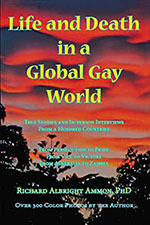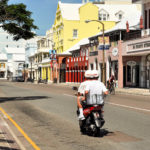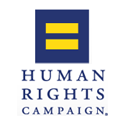By Lila Seidman
June 3, 2016
At the only gay bar in the most sparsely populated independent country in the world, Zorig Alima tells me he’s a “penis shaman.” The proprietor of d.d/h.z says he can confidently predict men’s penis sizes and sexual predilections. He gives my companion a disputable “reading,” and dashes away to tend to friends and customers, explaining, “This place is like my living room.”
When Zorig returns, he brings us a frozen drink with Day-Glo layers. “It’s like gay life in Mongolia,” he says. “It looks bright and sweet, but it’s difficult to swallow.” (photo left: Sukhbaatar hero statue in Ulan Bator)
In Mongolia, it isn’t easy for a gay bar to fly under the radar, even in the center of Ulaanbaatar, the country’s biggest city, home to more than a third of Mongolia’s total population of 2.8 million. Outside the city, the steppes are home to some of the world’s last nomadic people. When the country was under Soviet rule from 1921 to 1990, all non-heteronormative expression of sexuality was taboo. Until 1989, homosexuality was illegal and punishable by imprisonment.
Gay life in Mongolia is still far from easy. For many Mongolians, gay visibility is seen as an invasion, a foreign influence corrupting traditional life. Bullying at school remains prevalent, labor discrimination is rife, police hostility abounds and healthcare and social services are frequently withheld.
Several Mongolian gay bars predate d.d/h.z., but they were forced to close due to resistance from the neighborhood or would-be clients steering clear, for fear of getting beaten up or harassed. The first, City Life, lasted just one fun but lonely summer in 2004. But d.d/h.z. is thriving. Several Mongolian men, three Europeans, and one elegantly dressed trans woman chat and make merry. Hands slip around shoulders. The blinds are drawn tight, but the atmosphere is open and casual. LED disco lights fling primary-colored-flecks on the revelers. Zorig even recently set up an LGBT Corner message board (and three dildos) to “make the message wide and open.”
Fewer than 18% of Mongolia residents have internet access, and until recently, information about anything related to gay life was nearly impossible to come by. When it does, it can be despairing. In the ‘90s, a famous and grisly incident disturbed the tiny country, when a Mongolian pop singer who was rumored to be gay was found beheaded in his apartment. Now, same-sex teen suicides crop up in the news with alarming frequency.
In 2010, Mongolia’s newly formed LGBT center reported on over a dozen hate-motivated instances of harassment, violence, and rape before the UN. In 2001, a lesbian woman was abducted, stabbed and raped by two men after the funeral of her girlfriend, who had committed suicide. In 2009, the ultra-nationalist neo-Nazi group Dayar Mongol kidnapped three transgender women in broad daylight and took them to a cemetery where they were beaten and sexually assaulted. None of the crimes were initially reported to “for fear of secondary victimization by police.”
Zorig “heard stories” about the existence of gay people growing up, but didn’t meet another gay man until he moved to Japan at 19. There, Zorig worked as an investment banker for 15 years “having a nice time enjoying my gay life” before moving back to Mongolia in 2012. “Coming back to Mongolia but not having a place to party is kind of sad,” he says. “So I thought, ok, let me just create that.” Gay men could meet at “secret parties,” but Zorig said he was tired of hiding. He knew that there were enough people living in the shadows to constitute a clientele. (photo left: Kharkhorin monastery)
He opened the dance club Hanzo, in mid-2012, and hosted drag shows, go-go dancing and karaoke. Police frequently raided the bar and physically assaulted club-goers. “Back in 2012, it was not cool,” Zorig says. “People were like, ‘What the fuck is that?’”
During Hanzo’s three-year existence, local police who interacted with Zorig and his clientele on a weekly basis gradually warmed to the bar. Members of Mongolia’s artistic elite, including the rock band The Lemons, frequented the bar. Because of their potent social influence, their acceptance informed wider, albeit measured, public acceptance.
Zorig notes that police in Hanzo’s centrally located Chingeltei District tend to be more familiar with the LGBT community—and therefore more accepting—than police in more far-flung districts. Just last year, police interrupted Ulaanbaatar’s Equality Walk and harassed participants.
The previous November, one of the most prominent trans men in Mongolia, Anaraa Nyamdorj, opened the now-defunct gay bar, 100%. Like Hanzo, the bar attracted grateful clientele seeking a safe haven, along with opposition. In February of 2012, Anaraa’s sister’s ex-boyfriend stormed into the bar and punched him in the face, fracturing his eye socket. At the time, hate crimes were not recognized under Mongolia’s Criminal Code and the case was dismissed.
Anaraa waged a three-year battle alongside local colleagues and the National Human Rights Commission against state authorities to register the LGBT Centre, Mongolia’s first and only LGBTI human rights organization. The roadblocks seemed innumerable, beginning with the Mongolian Ministry of Justice and Home Affairs denying official registration to the NGO and requiring that the LGBT Centre to obtain “a linguistic definition” of the words “lesbian,” “gay,” “bisexual” and “transgender” from the Linguistics Institute of the Mongolian Academy of Sciences.
Then, the State Registration Agency refused to register their name because its meaning “conflicts with Mongolian customs and traditions and has the potential to set a wrong example for youth and adolescents.” The Centre was finally officially recognized in 2009, just in time present their distressing report to the UN.
Anaraa now serves as the Centre’s executive director. On Dec. 3, 2015—Anaraa’s birthday—Mongolia passed a new Criminal Code that effectively recognizes “crimes of discrimination,” in large part due to the Centre’s international advocacy with UN treaty bodies and the UN Human Rights Council.
The law will take effect Sept. 1 this year and that’s “when we will see how much the police are able to understand [the law],” Anaraa says, acknowledging that the term “crimes of discrimination” is somewhat vague. To ensure that the police understand the law and apply it properly, the Centre will be training the police on what hate crimes are, how to recognize them and the kind of assistance hate crimes victims require.

The U.S. State Department is funding the project and the U.S. Embassy reserved the money for three years while LGBT advocates and activists waited for the law to pass. According to Anaraa, Mongolia is the first Asian country to have hate-crime and hate-speech regulations in its Criminal Code. (Some countries, including Hong Kong, Japan and Macau offer partial protection.)
(photo left: rural kids riding horses)
Anaraa now calls d.d/h.z “home” after 100% closed, in December 2012, after the landlord found out that the tenants had sublet the space to members of the LGBT community and subsequently terminated the lease.
“Back in 2012, it was not cool. People were like, ‘What the fuck is that?’”
Zorig believes d.d/h.z and Mongolia’s LGBT Centre have “big synergy”: as legal reforms beget social détente, those in the community “feel free and safe to go out – or come out.” Zorig thinks the bar’s visibility “made the straight community understand that these people are not monsters. They are not pedophiles and they are not perverted. They are just people.”
The same year as the Dayar Mongol neo-Nazis staged their transphobic attack, the LGBT Centre produced a film called “Lies of Liberty,” featuring an interview with one of the victims. According to Anaraa, the film helped stoked a public outcry. “What the ultra-nationalists did was shameful because they were targeting their own flesh and blood,” he says.
A mining boom in 2008 brought a deluge foreign investment and cultural influence, which triggered the rise of several ultra-nationalist groups. Far from embodying the Aryan phenotypic ideal, Mongolian neo-Nazis tend to emphasize their reverence of Hitler’s obsession with national identity and ethnic purity, and have notoriously wrought violence against the LGBT community and foreigners, especially those in the company of Mongolian women. Recently, the ultra-nationalists have focused their ire on foreigners, in particular, the Chinese, who they believe are exploiting their economy and natural resources. Some groups, including Tsagaan Khass (White Swastika), have rebranded themselves as environmental groups fighting pollution generated by foreign-owned mines.
About a year after the attack, Dayar Mongol issued a formal apology to the victims. Anaraa says he hasn’t heard a single report of violence carried out by the ultra-nationalists against the LGBT community since the public apology.
Late on a Saturday night, the music is subtle and the lights relatively bright. There’s more of a café than party ambiance. At 3:30 am, people are still streaming in and out. Men sit at the bar, poised to cruise. Groups—dressed almost exclusively in tight jeans and black shirts and black zip up jackets—huddle into wooden booths. A belligerent drunk man stumbles in and Zorig escorts him out.
Not long ago, Zorig says he spoke with the leader of umbrella ultra-nationalist group Khukh Mongol (Blue Mongolia), which includes Dayar Mongol, who told him the group no longer sees the LGBT community and proprietors like Zorig as their enemies. The leader’s friend, an older trans woman, came out to him last year. The leader and other members of Blue Mongolia even visited Hanzo a few times themselves. The leader told Zorig, “If anyone comes into your place and threatens you, just call me.”
Lila Seidman is a freelance reporter based in Los Angeles.
















